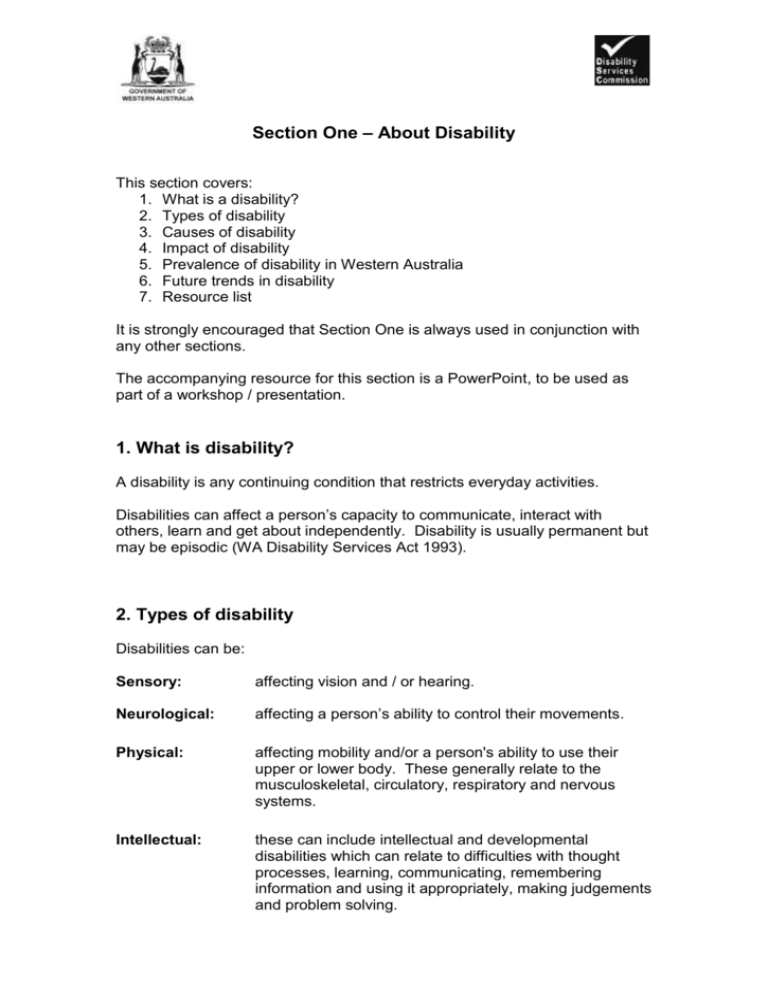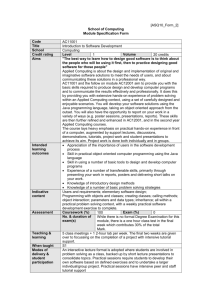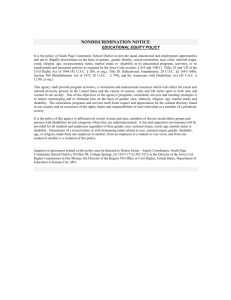Section One – Disability
advertisement

Section One – About Disability This section covers: 1. What is a disability? 2. Types of disability 3. Causes of disability 4. Impact of disability 5. Prevalence of disability in Western Australia 6. Future trends in disability 7. Resource list It is strongly encouraged that Section One is always used in conjunction with any other sections. The accompanying resource for this section is a PowerPoint, to be used as part of a workshop / presentation. 1. What is disability? A disability is any continuing condition that restricts everyday activities. Disabilities can affect a person’s capacity to communicate, interact with others, learn and get about independently. Disability is usually permanent but may be episodic (WA Disability Services Act 1993). 2. Types of disability Disabilities can be: Sensory: affecting vision and / or hearing. Neurological: affecting a person’s ability to control their movements. Physical: affecting mobility and/or a person's ability to use their upper or lower body. These generally relate to the musculoskeletal, circulatory, respiratory and nervous systems. Intellectual: these can include intellectual and developmental disabilities which can relate to difficulties with thought processes, learning, communicating, remembering information and using it appropriately, making judgements and problem solving. Cognitive: affecting a person's thought processes, personality and memory resulting, for example, from an injury to the brain. Psychiatric: affecting a person’s emotions, thought processes and behaviour. Some disabilities, such as epilepsy, are hidden, while others, such as cerebral palsy, may be visible. Physical disabilities are the most common (73 per cent), followed by intellectual/psychiatric (17 per cent) and sensory (10 per cent). People may have more than one disability and may experience additional disadvantages to adequate service provision due to factors such as being from culturally and linguistically diverse backgrounds or because they live outside the metropolitan area or outside a regional centre. 3. Causes of disability The causes of disability vary. As a person ages the severity of the disability can change. Disabilities may be: genetically determined; environmentally determined; or of unknown cause. A genetically determined disability is usually inherited from the parents. However, a new genetic error can occur leading to symptoms of the condition. Examples of this are cystic fibrosis and muscular dystrophy. An environmentally determined disability results from an accident, injury, disease or infection. Examples include acquired brain injury, spinal cord injury and diabetes. Sometimes a disability is of unknown origin. This is the case with many physical and intellectual disabilities. Disabilities vary according to individual circumstances. 4. The impact of disability While the degree and type of disability varies with individual circumstances, people with disabilities frequently report that they experience difficulty being independently mobile, or being able to see, hear, or communicate. As a consequence, people with disabilities face barriers with everyday activities such as hearing or understanding what is said, seeing small print, climbing stairs or understanding signage. The impact on the life of the person concerned can be major, particularly if the individual has multiple disabilities. Often people with disabilities are unable to do things most of us take for granted, such as: reading and understanding public notices or newsletters; accessing websites; participating at the local swimming pool or recreation centre; playing on the play equipment at the park; hearing what is said at a public meeting; and shopping at the local shops. The exact impact of a disability on the life of an individual varies according to a number of factors including: the specific nature and severity of the disability; the person’s strength, stamina, size, weight and age; the person’s ability to cope; and the physical, social and economic environment within which the person is living. Communities which are accessible and inclusive minimises the effect of disability. 5. Prevalence of disability in WA Disability affects one third of the Western Australian population. The Australian Bureau of Statistics (ABS) estimates that there are 405,500 Western Australians that have reported to having a disability (20.6 per cent of the total population). An estimated 246,800 Western Australians are carers for people with disabilities (12.6 per cent of the total population) (source ABS). One in every 17 Western Australians aged 15 and over (91,600 people) has a disability and is also a carer of a person with disabilities (source ABS). Of the 405,500 Western Australians with disabilities, 115,800 people have profound or severe core activity limitation (source ABS). Profound limitation refers to when a person is unable to do, or always needs help or supervision to carry out the functions of daily living. Severe limitation refers to when a person sometimes needs help or supervision with daily living routines or has difficulty understanding or being understood by family or friends or can communicate more easily using non-spoken forms of communication. Most people with disabilities experience some form of limitation or restriction due to their disability. The Commission’s website provides profiles on different regions in Western Australia. The profiles give an estimate of the number of people with disabilities for that area, as well as the number of the Commission service users and the number of people receiving from Centrelink a Disability Support Pension and / or Carer Allowance for their child(ren). 6. Future trends in disability The number of Western Australians with disabilities is increasing. The ABS conducts regular surveys on disability to report the extent of disability in Australia, the need for support and the adequacy of support, and the contribution of informal care. The 2003 Survey of Disability, Ageing and Carers figures for prevalence of disability show an increase since 1998 of 50,000 in the number of Western Australians with a disability. Between 2006 and 2026 the number of people with disabilities in Western Australia is expected to increase by more than 210,000. This increase is mainly due to our ageing population. People may have a disability at any age, but the likelihood of having a disability increases as people get older. ABS data indicates that 51 per cent of Western Australians over 60 years of age have a disability. The number of older Western Australians with disabilities will increase substantially as the ‘baby boomers’ move into age groups in which disability is more prevalent. It is expected that there will be an overall increase of 115.7 per cent over the next 20 years. 7. Resources Profile of disability in Western Australia – www.disability.wa.gov.au WA Disability Services Act 1993 Oral histories - by people in the disability field on their experiences with disability in Western Australia. Housed at the Battye Library. Lost Generations project - short films capturing the essence of individuals with disabilities. (Available through the Commission’s Accommodation Directorate) Australian Bureau of Statistics - www.abs.gov.au







